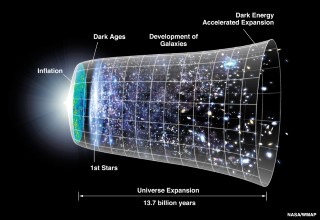Wide-Field Infrared Survey Telescope: WFIRST will perform three surveys to provide scientists with data that can help us to understand the unknown entity dark energy. The High Latitude Spectroscopic Survey will measure redshifts and positions of galaxies. The Type Ia Supernovae Survey will measure absolute distances using Type Ia supernovae as standard candles. The High Latitude Imaging Survey will measure the shapes and photometric redshifts of galaxies and galaxy clusters.
Credit: NASA / GSFC
We still have many mysteries for which we do not have answers or explanations. Using astrophysical considerations, we know the mass of the Universe. A fraction of the Universe, the stuff we’re familiar with, the stuff people are made out of, the stuff oceans are made out of, called baryons, makes up only about 4% of the Universe. The Universe is probably about 25% so-called dark matter; we don’t know what it is, but we know about its presence through the effects of its gravity acting on ordinary matter. We’re hopeful that the high-energy physicists will give us some answers in the next couple of years. The rest is a recent discovery called dark energy; we’ve really got no idea what it is! We sense the dark energy by the fact that the expansion of the Universe seems to be accelerating. I think these are very exciting times. For a student today there is much more “unknown” than when I was a student.
To understand the baryons, the dark matter, and the dark energy, we need to be able to detect and study them. We're having a hard time detecting just the 4% that is thought to be baryons; it may be that we can detect the baryons with high-resolution X-ray spectroscopy, but it’s going to be tough. There is a problem there. For any baryons we can detect, we have to compare the amount we actually see with the total baryonic mass that we infer from other arguments. I’ll come back to that.
Time and again, we’ve had to say that we thought we had it all figured out, that we thought we knew how many baryons would be measured with X-ray absorption, how many with ultraviolet absorption and so forth, but then when we add everything up, we do not come up with the right answer. In the local Universe, we may be off by a factor of 2. It is as if you bought a pound of candy at the store and when you arrived home you discovered that there was only half of a pound in the bag. This would be off by a factor of 2. So, we go back to the drawing board. We build new instruments; we make new observations trying to make the balance sheet work out. We are still working on that. Is the theory wrong or are the observations incomplete?
For dark matter and dark energy, there is nothing that we can observe directly, and this is over 90% of the mass of the Universe. As I alluded to above, physicists are working very hard to detect dark matter particles. Dark energy is an entirely different issue and a very hard problem. NASA is planning a new mission, WFIRST, that will measure the effects of dark energy.


